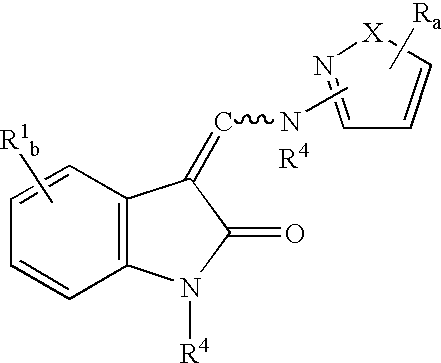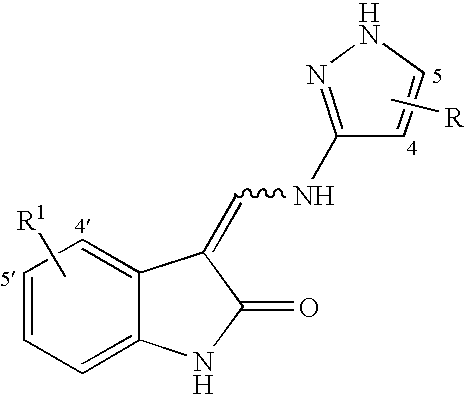3-(heteroarylamino)methylene-1, 3-dihydro-2H-indol-2-ones as kinase inhibitors
- Summary
- Abstract
- Description
- Claims
- Application Information
AI Technical Summary
Benefits of technology
Problems solved by technology
Method used
Image
Examples
example 1
3-[(1-H-Pyrazol-3 ylamino)methylene]-1,3-dihydro-indol-2-one
[0084]2.42 mL of ethylformate are combined with 1.33 gms of 1,3 dihydro-indol-2-one in a solution of 21%, by weight, sodium formate in ethanol. The resulting solution is allowed to stand at room temperature for 30 minutes and then refluxed for 30 minutes to yield a suspension. Once at room temperature the suspension was acidified to pH 1.0 with 10% HCl(aq), then 5 mL of H2O was added. The resulting precipitate was filtered and washed with H2O (4×20 mL) to provide a mixture of E & Z 3-[(hydroxy)-methylene]-1,3-dihydro-indol-2-one as a solid.
[0085]E & Z-3-[(hydroxy)-methylene]-1,3-dihydro-indol-2-one (0.10 g) is reacted with 0.1756 gms of 3-aminopyrazole by refluxing in tetrahydrofuran (2.7 mL) for 48 hours to yield 0.11 gms of the named compound as a solid following concentration in vacuo, dilution with isopropanol and filtration.
example 2
3-[(5-Phenyl-H-pyrazol-3-ylamino)-methylene]-1,3-dihydro-indol-2-one
[0086]The named compound is prepared by substituting 3-amino-5-phenylpyrazole for 3-aminopyrazole in the reaction of Example 1. Specifically, E & Z-3-[(hydroxy)-methylene]-1,3-dihydro-indol-2-one (0.10 gms.) is reacted with 0.2002 gms. of 3-amino-5-phenylpyrazole by refluxing in tetrahydrofuran (2.5 mL).
[0087]The compounds of Example 3 through 58 are prepared by substituting the appropriate substituted 3-aminopyrazole, 5-aminopyrazole or aminoisoxazole for 3-aminopyrazole, or the appropriate 4′-methyl or 5′-fluoro or 5′-chloro or 6′-fluoro substituted 1,3 dihydro-indol-2-one for 1,3 dihydro-indol-2-one in the reaction of Example 1.
example 3
3-[(5-P-Tolyl-1H-pyrazol-3-ylamino)-methylene]-1,3-dihydro-indol-2-one
[0088]The named compound is prepared by substituting 3-amino-5-(p-tolyl)-pyrazole for 3-aminopyrazole in the reaction of Example 1. Specifically, E & Z-3-[(hydroxy)-methylene]-1,3-dihydro-indol-2-one (0.10 gms.) is reacted with 0.1480 gms. of 3-amino-5-(p-tolyl)-pyrazole by refluxing in tetrahydrofuran (2.5 mL).
PUM
| Property | Measurement | Unit |
|---|---|---|
| Inhibition | aaaaa | aaaaa |
| Inhibition | aaaaa | aaaaa |
| Inhibition | aaaaa | aaaaa |
Abstract
Description
Claims
Application Information
 Login to View More
Login to View More - R&D
- Intellectual Property
- Life Sciences
- Materials
- Tech Scout
- Unparalleled Data Quality
- Higher Quality Content
- 60% Fewer Hallucinations
Browse by: Latest US Patents, China's latest patents, Technical Efficacy Thesaurus, Application Domain, Technology Topic, Popular Technical Reports.
© 2025 PatSnap. All rights reserved.Legal|Privacy policy|Modern Slavery Act Transparency Statement|Sitemap|About US| Contact US: help@patsnap.com



